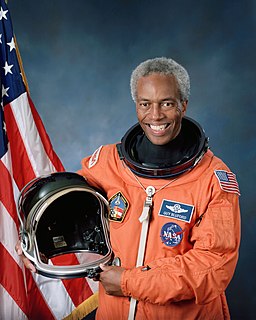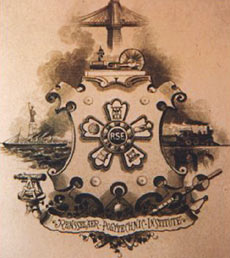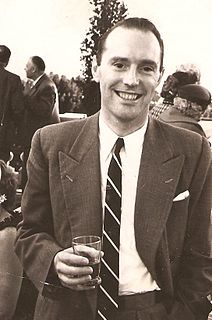
Guion Stewart Bluford Jr. is an American aerospace engineer, retired U.S. Air Force officer and fighter pilot, and former NASA astronaut, who is the first African American and the second person of African descent after Arnaldo Tamayo Méndez to go to space. Before becoming an astronaut, he was an officer in the U.S. Air Force, where he remained while assigned to NASA, rising to the rank of colonel. He participated in four Space Shuttle flights between 1983 and 1992. In 1983, as a member of the crew of the Orbiter Challenger on the mission STS-8, he became the first African American in space as well as the second person of African ancestry in space, after Cuban cosmonaut Arnaldo Tamayo Méndez.

The Tau Beta Pi Association is the oldest engineering honor society and the second oldest collegiate honor society in the United States. It honors engineering students in American universities who have shown a history of academic achievement as well as a commitment to personal and professional integrity. Specifically, the association was founded "to mark in a fitting manner those who have conferred honor upon their Alma Mater by distinguished scholarship and exemplary character as students in engineering, or by their attainments as alumni in the field of engineering, and to foster a spirit of liberal culture in engineering colleges".

Henry Petroski is an American engineer specializing in failure analysis. A professor both of civil engineering and history at Duke University, he is also a prolific author. Petroski has written over a dozen books – beginning with To Engineer is Human: The Role of Failure in Successful Design (1985) and including a number of titles detailing the industrial design history of common, everyday objects, such as pencils, paper clips, toothpicks, and silverware. His first book was made into the film When Engineering Fails. He is a frequent lecturer and a columnist for the magazines American Scientist and Prism.

Eta Kappa Nu (ΗΚΝ) or IEEE-HKN is the international honor society of the Institute of Electrical and Electronics Engineers (IEEE). "The organization promotes excellence in the profession and in education through an emphasis on scholarship, character, and attitude." Membership is a lifelong designation for individuals who have distinguished themselves as students or as professionals in electrical engineering, computer engineering, computer science, and other fields of IEEE interest.
Romesh C. Batra is a University Distinguished Professor and Clifton C. Garvin Professor of Engineering Science and Mechanics at Virginia Polytechnic Institute and State University, Blacksburg, Virginia. He was born in Village Dherowal, Punjab, India. His family migrated from Dherowal to Shahabad Markanda, Haryana, India after India became an independent country. Dr. Batra has authored the book, Elements of Continuum Mechanics, AIAA Educational Series. His research group has published in reputable refereed and widely read journals more than 460 papers of which about 40 are single-authored and nearly 320 have two authors; these are documented on the website: http://www.beam.vt.edu/batra.

Francis Trenholm Crowe was a civil engineer and employee of Morrison-Knudsen, who later became in 1931, the General Construction Superintendent of the Hoover Dam construction contract.

Clayton Daniel Mote Jr. is the President Emeritus of the National Academy of Engineering. He served as the president of the NAE from July 2013 to June 2019. He also served as President of the University of Maryland, College Park from September 1998 until August 2010. From 1967 to 1991, Mote was a professor in mechanical engineering at the University of California, Berkeley, and served as Vice Chancellor at Berkeley from 1991 to 1998. Mote is a judge for the Queen Elizabeth Prize for Engineering.

Adel S. Sedra is an Egyptian Canadian electrical engineer and professor.

The Rensselaer Society of Engineers (RSE) is a social fraternity founded in 1866 at Rensselaer Polytechnic Institute in Troy, NY. Originally named The Pi Eta Scientific Society, the organization was incorporated in 1873 in the state of New York. Arriving on campus at about the same time as some of the first fraternities, it has remained one of the oldest "local" organizations in the U.S. RSE is the only independent fraternity at Rensselaer. They have chosen to remain independent to maintain the freedom to set their own policies and make their own managerial decisions. Contrary to what their name may imply, members major not only in engineering, but also in such disciplines as science, management, architecture, and the arts. Society members are active in not only campus and local activities, but are also in many national organizations.

John Ripley Freeman was an American civil and hydraulic engineer. He is known for the design of several waterworks and served as president of both the American Society of Civil Engineers and the American Society of Mechanical Engineers.
James Lynah was an American businessman and sports administrator who is considered the principal founder of the Eastern College Athletic Conference. Lynah Rink is named in his honor.
Claude Maxwell "Max" Stanley (1904–1984) was an American civil engineer, entrepreneur, philanthropist, peace activist, author and world citizen. He founded Stanley Consultants, an engineering and consulting firm, in 1939 with his younger brother Art. In 1943 he co-founded HON Industries, originally named Home-O-Nize, an office furniture manufacturing company; and, along with his wife Elizabeth, created and endowed the Stanley Foundation in 1956, which is a global policy organization which focuses on mitigating climate change, avoiding the use of nuclear weapons, and preventing mass violence and atrocities. All three organizations are headquartered in Muscatine, Iowa, United States.
Texnikoi was founded in 1924 as an honorary organization for students in the College of Engineering at Ohio State University. Its purpose is to give due recognition to those members of the College of Engineering who have distinguished themselves as campus leaders while maintaining, at the same time, a commendable scholastic record.
John A. Swanson is an American engineer, entrepreneur, and philanthropist. Swanson is the founder of ANSYS, Inc., a John Fritz Medal winner, and a member of the National Academy of Engineering. He is internationally regarded as an authority and pioneer in the application of finite-element methods to engineering.
Kanwar Sain, also spelt as Rai Bahadur Kanwar Sain OBE (1899–1979) was a civil engineer from Haryana state in India. He was the chief engineer in the Bikaner state who came up with idea of Rajasthan Canal. He also successfully implemented Ganga canal project. He was considered a doyen of irrigation engineering of his time. He was born in 1899 in Tohana in Hisar district (Haryana). He was educated at D.A.V. College, Lahore. He graduated as a civil engineer from Thomason College of Civil Engineering, Roorkee in the year 1927 with hons. He was awarded Padma Bhushan in 1956. He has written a book called -Reminiscences of an engineer. He was chairman of Central Water and Power Commission, Ministry of Irrigation and Power, Government of India. Kanwar sain and Karpov (1967) presented enveloping curves for Indian rivers.
Dan Mircea Frangopol is an American civil engineer and the inaugural holder of the Fazlur R. Khan Endowed Chair of Structural Engineering and Architecture at Lehigh University, Bethlehem, Pennsylvania.

Harry Bolton Seed was an educator, scholar, former Professor at the University of California, Berkeley. He was regarded as the founding father of geotechnical earthquake engineering.

Ashraf Habibullah is a Pakistani-American structural engineer and software developer best known as the founder, President, and CEO of Computers and Structures, Inc., a structural and earthquake engineering software company based in Berkeley, California. Upon founding the privately held company in 1975, Ashraf co-created the first structural-engineering software available to the personal computer, and has since created a suite of products, and developed their capabilities. Notably, ETABS, a multi-story building analysis and design software, received recognition as one of the Applied Technology Council and Engineering News-Record Top Seismic Products of the 20th Century.
Martha Ann Evans Sloan is an American electrical engineer. She taught engineering for many years at Michigan Technological University, and became the first female president of the IEEE. Her service to the profession has been honored by several society fellowships and awards.

Ronald A Roy is an American engineer, physicist, and academic, who is an expert in physical acoustics and its applications to ultrasonics, biomedical acoustics, acousto-optics, cavitation, and bubble swarm acoustics.











